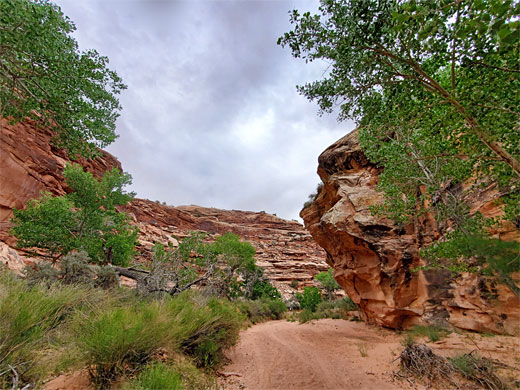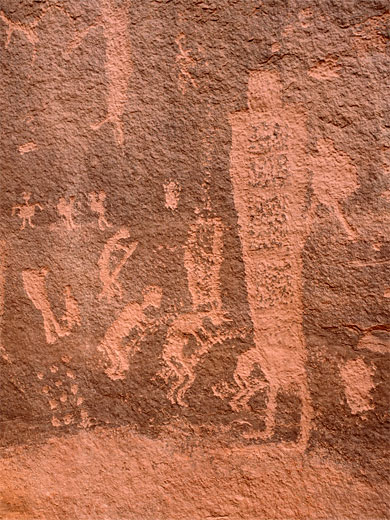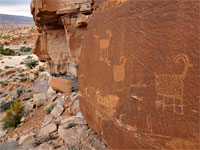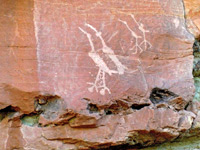Sevenmile Canyon
Main and south forks of a relatively shallow red rock canyon north of Moab, containing a number of large panels of pictographs and petroglyphs. Easy access from Hwy 313
Length: 2.6 miles
Elevation change: 100 feet
Difficulty: Moderate
Type: One-way
Usage: Low
Season: All year
Trailhead: Pullout along Hwy 313, 13 miles from downtown Moab
Rating (1-5): ★★★★★
Elevation change: 100 feet
Difficulty: Moderate
Type: One-way
Usage: Low
Season: All year
Trailhead: Pullout along Hwy 313, 13 miles from downtown Moab
Rating (1-5): ★★★★★
Some of the best, most accessible rock art near Moab is found along the main and south forks of Sevenmile Canyon, a relatively shallow drainage that provides a course for Hwy 313, to Dead Horse Point and the Island in the Sky district of Canyonlands National Park, and is perhaps named on account of its distance north of the Colorado River. The canyon is bordered by reddish-brown cliffs of Wingate sandstone, topped by ledgy, lighter-colored strata of the Kayenta formation, and the smooth rock faces, often with dark patina, provide an ideal canvas for petroglyphs and pictographs, reflecting the long history of use of the canyon as a cross-country travel route.
There are at least nine rock art sites, three along the highway in the main canyon, and six in the south fork, all viewable on a hike of less than 3 miles - mostly level, with just a few short climbs to some of the panels.
The trailhead, not marked, is a pull-out on the north side of the highway, 11 miles from downtown Moab, and although the road is often busy, with traffic to and from Canyonlands, very few people explore the canyon.
19 views of the canyon.
View of the canyon from the bench below the snake-in-mouth pictograph.
Moab area map.
From the pull-out along the main fork of Sevenmile Canyon, a very short path leads northwards to the base of the cliff, from where the most famous site in the area is 100 feet west - this is the intestine man panel, a collection of unusually intricate and detailed pictographs centered on three human-like figures, the middle one including a depiction of the intestines. Above and to the right are other designs, more faded. This panel is around 15 feet up on a ledge, and although the pictographs are relatively, small they are easy to spot from a distance. In the other direction from the path, on a particularly dark section of the cliff face, are a sizable group of petroglyphs including a spiral, a star and three bighorn sheep, rectangular in outline. A separate petroglyph site, where designs include another sheep and two triangular figures, is situated a quarter of a mile east, around a corner, about 40 feet above the valley floor atop a steep incline.
The third site along the highway, in the main fork of the canyon, is the snake-in-mouth panel, pictographs - two large red figures, one with a small blue snake in its mouth, and two other serpents on the left and right. One of the effigies is holding a creature, perhaps a bird. These designs are examples of the Barrier Canyon Style, named after the famous panels in Horseshoe (formerly Barrier) Canyon. The figures are located towards the east end of a broad, desert varnish-streaked alcove about half way up the cliffs on the south side of the canyon - reached by crossing the road, descending to the streambed of the north fork then over the south fork just beyond, across a bushy area and a little gully then up a rocky slope to the west end of the alcove and finally along a ledge to the site, which has commanding views up and down the valley.
The first site in the south fork of the canyon, very close to the confluence, is just beyond the start of the cliffs on the west side, above a sandy slope, with designs including anthropomorphic figures, bighorn sheep, snakes and antelope. To the south, the canyon has a wide streambed of soft sand, used as a track by ATVs, bordered by bushy banks and low cliffs. The second, and best of the South Fork sites is half a mile from the first, on the opposite (east) side, where a little promontory has created a north-facing cliff, just beyond a group of cottonwood trees; accessed by walking up a slope and along a ledge. The most famous petroglyph is the stickman, looking like a combination of a human figure and a scorpion; just beyond is the main group, consisting of assorted human figures and animals.
The third site, 0.3 miles further south and also on the east side of the canyon, is just before the streambed forms a U-shaped bend, at the mouth of a tributary. This though is modern in appearance - different in style, more angular, and crisp and lighter in color; it is positioned in a low alcove, beyond a clump of bushes. Site four is close by, around a wide bend in the canyon; at the west end of a broad, north-facing alcove, and quite hidden since the designs are on the underside of an overhanging rock, visible only when close-up - the main pictographs here include a snake and a figure thought to represent a centipede.
The fifth site, also not obvious, is high up on a north-facing wall just beyond the mouth of a west-side tributary canyon, 1.9 miles from the highway; a single, well preserved pictograph, resembling a shaman, on an angled rock face protected from the weather by a broad overhang above. The site is about 400 feet from the tip of the cliffs dividing the tributary from the main canyon, which by this point has become quite narrow. The ATV track runs ony a short distance further, up to a fence marking the limit of vehicular traffic. The southernmost rock art site is just beyond, on a southwest-facing clifff above a pile of fallen boulders - a large, faded Barrier Canyon Style pictograph plus two even fainter designs to the right.
There are at least nine rock art sites, three along the highway in the main canyon, and six in the south fork, all viewable on a hike of less than 3 miles - mostly level, with just a few short climbs to some of the panels.
The trailhead, not marked, is a pull-out on the north side of the highway, 11 miles from downtown Moab, and although the road is often busy, with traffic to and from Canyonlands, very few people explore the canyon.
Photographs
19 views of the canyon.
Sevenmile Canyon Video
View of the canyon from the bench below the snake-in-mouth pictograph.
Location
Moab area map.
Intestine Man, and Nearby Petroglyphs
From the pull-out along the main fork of Sevenmile Canyon, a very short path leads northwards to the base of the cliff, from where the most famous site in the area is 100 feet west - this is the intestine man panel, a collection of unusually intricate and detailed pictographs centered on three human-like figures, the middle one including a depiction of the intestines. Above and to the right are other designs, more faded. This panel is around 15 feet up on a ledge, and although the pictographs are relatively, small they are easy to spot from a distance. In the other direction from the path, on a particularly dark section of the cliff face, are a sizable group of petroglyphs including a spiral, a star and three bighorn sheep, rectangular in outline. A separate petroglyph site, where designs include another sheep and two triangular figures, is situated a quarter of a mile east, around a corner, about 40 feet above the valley floor atop a steep incline.
Snake-in-the Mouth Panel
The third site along the highway, in the main fork of the canyon, is the snake-in-mouth panel, pictographs - two large red figures, one with a small blue snake in its mouth, and two other serpents on the left and right. One of the effigies is holding a creature, perhaps a bird. These designs are examples of the Barrier Canyon Style, named after the famous panels in Horseshoe (formerly Barrier) Canyon. The figures are located towards the east end of a broad, desert varnish-streaked alcove about half way up the cliffs on the south side of the canyon - reached by crossing the road, descending to the streambed of the north fork then over the south fork just beyond, across a bushy area and a little gully then up a rocky slope to the west end of the alcove and finally along a ledge to the site, which has commanding views up and down the valley.
Confluence Petroglyphs, and the Stickman Panel
The first site in the south fork of the canyon, very close to the confluence, is just beyond the start of the cliffs on the west side, above a sandy slope, with designs including anthropomorphic figures, bighorn sheep, snakes and antelope. To the south, the canyon has a wide streambed of soft sand, used as a track by ATVs, bordered by bushy banks and low cliffs. The second, and best of the South Fork sites is half a mile from the first, on the opposite (east) side, where a little promontory has created a north-facing cliff, just beyond a group of cottonwood trees; accessed by walking up a slope and along a ledge. The most famous petroglyph is the stickman, looking like a combination of a human figure and a scorpion; just beyond is the main group, consisting of assorted human figures and animals.
More Rock Art
The third site, 0.3 miles further south and also on the east side of the canyon, is just before the streambed forms a U-shaped bend, at the mouth of a tributary. This though is modern in appearance - different in style, more angular, and crisp and lighter in color; it is positioned in a low alcove, beyond a clump of bushes. Site four is close by, around a wide bend in the canyon; at the west end of a broad, north-facing alcove, and quite hidden since the designs are on the underside of an overhanging rock, visible only when close-up - the main pictographs here include a snake and a figure thought to represent a centipede.
The Southernmost Sites
The fifth site, also not obvious, is high up on a north-facing wall just beyond the mouth of a west-side tributary canyon, 1.9 miles from the highway; a single, well preserved pictograph, resembling a shaman, on an angled rock face protected from the weather by a broad overhang above. The site is about 400 feet from the tip of the cliffs dividing the tributary from the main canyon, which by this point has become quite narrow. The ATV track runs ony a short distance further, up to a fence marking the limit of vehicular traffic. The southernmost rock art site is just beyond, on a southwest-facing clifff above a pile of fallen boulders - a large, faded Barrier Canyon Style pictograph plus two even fainter designs to the right.
Sevenmile Canyon - Similar Hikes
All Contents © Copyright The American Southwest | Comments and Questions | Contribute | Affiliate Marketing Disclosure | Site Map



















